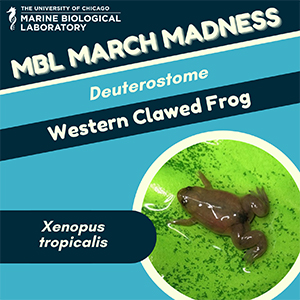MBL March Madness: Western Clawed Frog


Xenopus tropicalis is used widely as a model organism to study vertebrate biology and the genetic, biochemical, and environmental factors that influence development. The National Xenopus Resource at the MBL is home to more than 4,000 X. tropicalis individuals, including many mutant and transgenic lines. These frogs are used by MBL’s year-round and visiting researchers for a wide variety of research topics including sex determination, modeling genetic diseases, as well as developmental and evolutionary biology. (ID Card Photo Credit: James Parente | Equipment: iPhone)
Cool facts
- It is the only species in the genus Xenopus to have a diploid genome, making it ideal for genome editing.
- It is widely used in research because of its powerful combination of experimental tractability and close evolutionary relationship with humans.
- It can produce thousands of offspring from a single clutch of eggs.
Select Publications
Szenker-Ravi, E., Altunoglu, U., Leushacke, M. et al. RSPO2 inhibition of RNF43 and ZNRF3 governs limb development independently of LGR4/5/6. Nature 557, 564–569 (2018). doi.org/10.1038/s41586-018-0118-y
Willsey HR, Exner CRT, Xu Y, Everitt A, Sun N, Wang B, Dea J, Schmunk G, Zaltsman Y, Teerikorpi N, Kim A, Anderson AS, Shin D, Seyler M, Nowakowski TJ, Harland RM, Willsey AJ, State MW. Parallel in vivo analysis of large-effect autism genes implicates cortical neurogenesis and estrogen in risk and resilience. Neuron. 2021 Mar 3;109(5):788-804.e8. doi.org/10.1016/j.neuron.2021.01.002
Furman BLS, Cauret CMS, Knytl M, Song XY, Premachandra T, Ofori-Boateng C, Jordan DC, Horb ME, Evans BJ. A frog with three sex chromosomes that co-mingle together in nature: Xenopus tropicalis has a degenerate W and a Y that evolved from a Z chromosome. PLoS Genet. 2020 Nov 9;16(11):e1009121. doi.org/10.1371/journal.pgen.1009121
Marquez J, Mann N, Arana K, et al DLG5 variants are associated with multiple congenital anomalies including ciliopathy phenotypes Journal of Medical Genetics. doi.org/10.1136/jmedgenet-2019-106805
Division: Deuterostome
Deuterostomia may not sound familiar, but it should: you are a deuterostome! Most deuterostomes belong to one of two groups that include most of its members—echinoderms, which includes animals such as the spiny-skinned starfish, sea urchins, and their relatives, and chordates, which include fish and other vertebrates (including humans). Learn more about the Deuterostome Division.
Meet the Other Deuterostome Organisms
-
- Axolotl (Ambystoma mexicanum)
- Sea Squirt (Ciona intestinalis)
- Acorn Worm (Saccoglossus kowalevskii)
What is MBL March Madness?
Based on the March Madness NCAA basketball tournament, during MBL March Madness, popular MBL organisms face off for your votes. YOU have the opportunity to decide what organism is crowned victorious by voting for your favorite organisms in a series of head-to-head match-ups. Voting will take place on the MBL social media channels from March 29 - April 7. Learn more and download a bracket at mbl.edu/march-madness.